Interview : Yosuke Bandai 万代洋輔

Yosuke Bandai
万代洋輔
万代洋輔は写真を中心に、映像やオブジェなどを用いながら作品を作る美術家だ。10年近くのキャリアの中で、一貫して朽ちた物への関心を示し、『蓋の穴』シリーズから継続的に廃棄物を自身の手で再構成した上で撮影するプロセスで制作している。作品に漂う独特の造形感覚は他に類を見ない。なぜ捨てられた物へ興味を示すのか、制作の背後にどのような思想が潜んでいるのだろうか。
また、万代は先天性の双極性障害を抱えている。今では全く問題ないと語るが、2008年からおよそ5年間はその症状が悪化し、満足な日常生活を送ることができなかったという。治療のために制限を設けて心身のバランスを整えながら日々を過ごす。そういった経験は制作や作品にどのような影響を及ぼすのだろう。
これらの興味をきっかけに、初の出版物『A Certain Collector B』のリリースに際してインタビューを行った。
万代洋輔をよりよく知るために彼の言葉を共有したい。
なお、『A Certain Collector B』は2016年9月から10月にかけて、東京の現代美術ギャラリーTARO NASUで開催された個展「”Friday, September 9 – Friday, October 7, 2016″」において展示された同名の作品を収録している。路上で拾い集めた物の組み合わせから生まれた新たな形をフラットベッドスキャナーによって撮影したシリーズで、本書はそれらを蒐集する架空のコレクターBのアルバムというコンセプトで制作された。
Yosuke Bandai is a multidisciplinary artist whose practice is grounded in photography, yet also runs the gamut from film to sculptural objects. Over the course of a nearly decade long career, he has demonstrated an unwavering interest in themes of decay. Beginning with his futa no ana (“the lid on the hole”) series, Bandai’s process has been a continual exploration of found waste items which he collects, reassembles, and then photographs. His work exudes an unparalleled atmosphere of humor in tandem with a unique sense of physical form, both of which prompt the questions: What sparked his engagement with discarded items? What ideologies/thought process underlie and inform the creation of his work?
Moreover, Bandai is afflicted by congenital bipolar disorder. Although he states that he has learned to fully manage the condition now, he concedes that there was a five-year period between 2008 and 2012 when the symptoms amplified to an extent that precluded him from leading a fulfilling daily life. The road to recovery has involved attritional pacing in an ongoing quest for both psychological and physical balance. This experience with personal struggle has ostensibly left an indelible impact on Bandai’s practice, and provides a further – if not immediately evident – layer from which to approach his creations. In the interest of probing these questions and more, we interviewed Bandai to mark the release of his first print publication, A Certain Collector B. Read the full interview for a deeper look into the mind of Yosuke Bandai, in his own words.
A Certain Collector B includes work of the same title from his solo exhibition “Friday, September 9 – Friday, October 7, 2016” held at the contemporary art venue TARO NASU in Tokyo from September through October 2016. The series consists of images produced on a flatbed scanner that depict items gathered off the streets and reconstituted into new, sculptural amalgamations. The book’s concept is that it is a comprehensive personal document culled from the files of a fictive “Collector B,” a veritable homemade photo album of this anonymous collector’s coterie.
初個展からあっという間に10年が経ってしまいました。これまでを振り返ると自分や写真を通して、不要とされたものを扱いながら人間について考察してきたと言えます。その考察の過程に生まれた作品は、人生や文明の儚さについて詩的に表している側面があると思います。
一方で、対象といかに交わるかという事を徹底してやってきました。以前、小林秀雄の講演のCDを聞いている時に、本居宣長が考えるということについてどう考えたかという話が出てきました。そして、考えるということは対象と交わること、付き合うことだという話が出てきました。凄く腑に落ちたのを覚えています。
写真には鏡に似た側面があります。世界について把握する為であったり、私との対話を可能にする為に扱っています。
-シリーズ『蓋の穴』と新作『コレクターB』では、継続的に廃棄物を対象にオブジェを作り写真に収める手法を用いられています。朽ち果てた物、またそれに触れて弄る際に感じるのはどのようなことですか。スキャナーはオブジェを真下から撮影するので、モニターに出てくるまで色や形がわからない部分があります。モニターに画像が出てきた時や、弄る前の落ちているものとの出会いの瞬間も随分と様々に感じます。常に状況や状態は様々で、触れたり弄る時に感じる事の種類も様々です。そんな中でも好きな残滓を弄って童心にかえっていると、どんどん対象との関係が一対一になって盲目的になったりする事もあります。そこからさらに対象に愛着とかを感じた時には、どの声を聞けば良いのかとか色々と迷走して喜怒哀楽が渾然となる瞬間もあります。ですが、こういった活き活きとした童心を対象に定着させる事が、生命感覚を揺さぶるユーモアを作品に織り交ぜているのだと思います。
Ten years have flown by since my first solo exhibition. Looking back on my earlier work, I can say that I’ve used both myself and photography as vehicles by which to think about humanity, all the while handling materials that have been deemed “unnecessary” and tossed aside. I think that the work which has resulted from this process of inquiry is, to a certain degree, a poetic expression of the ephemerality of life and civilization.
At the same time, I’ve always been thoroughly engaged with the question of how to interact with a given subject. One day, I was listening to a CD recording of a lecture by Hideo Kobayashi [1902-1983; prominent literary critic and author], and he brought up Norinaga Motoori [1730-1801; pre-imminent Kokugo scholar in the Edo period], in the context of what Motoori thought about the act of thinking. Evidently, he said that the act of thinking is tantamount to interacting with the subject, to giving yourself over and committing to a subject. I still remember that moment, as it really struck a chord.
One aspect is that photographs are akin to a mirror. I work with photography in order to grasp an understanding of the world, and also to enable a sort of conversation with myself.
-In both the “lid on the hole” series and your new work “Collector B,” you’ve elected to continuously produce objects out of discarded materials, then capture these sculptural objects in photographs. What is it that draws you to decay? What do you feel when handling and finessing these worn-out materials?The scanner photographs from directly overhead, so there are certain aspects of an object’s color and form that are only revealed to me when I see them on the monitor. The feelings are quite diverse, and vary from the time I first spot a piece of debris on the ground to when the image first appears on the screen. The circumstances and situations are in perpetual flux. My feelings when touching and fiddling with the material also falls into a number of different categories. Sometimes when I’m working with a particularly exciting vestigial remain and feeling like a kid in a candy store, I reach a transfixed, trancelike state, where I gradually become one with the subject material. At other times when I feel an even deeper, almost love-like attachment to a subject, there are moments when I reach an impasse, and debating the next move experience a harmonious flash of the full range of emotions. However, I think that being able to imbue a subject with this kind of vibrant childish innocence instills my work with humor that jolts our perception of existence.
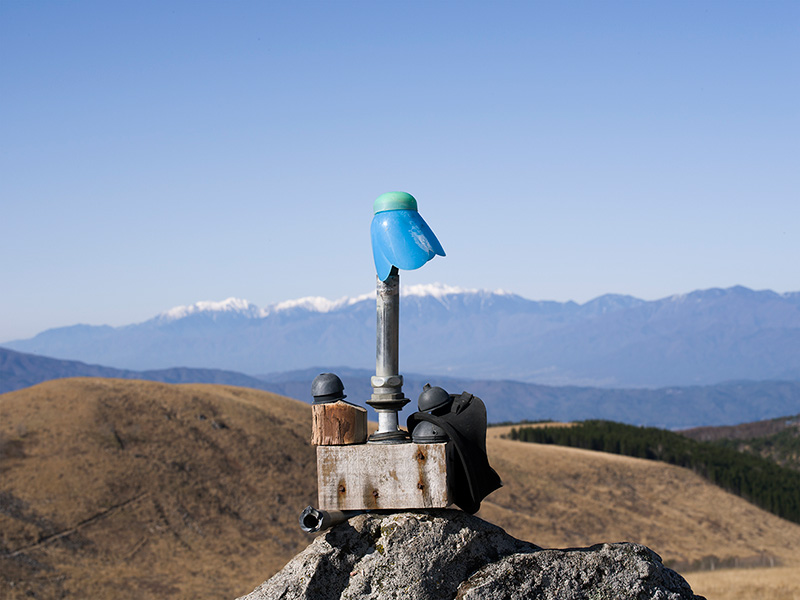
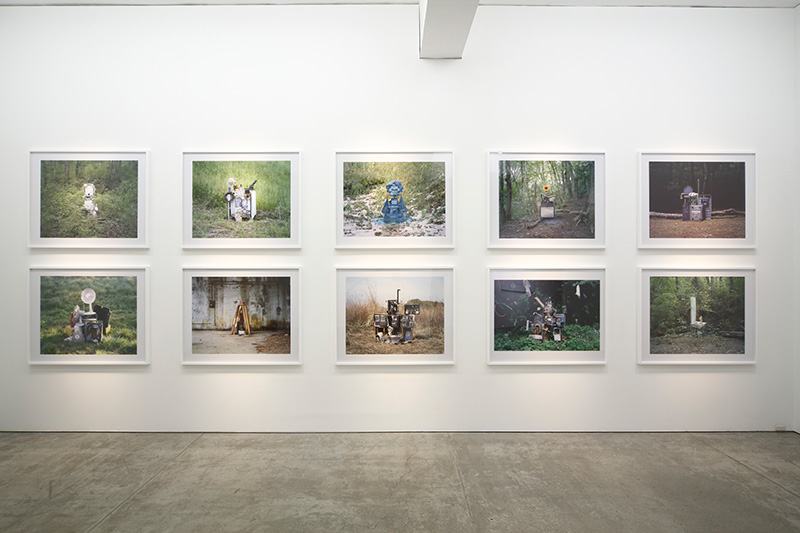
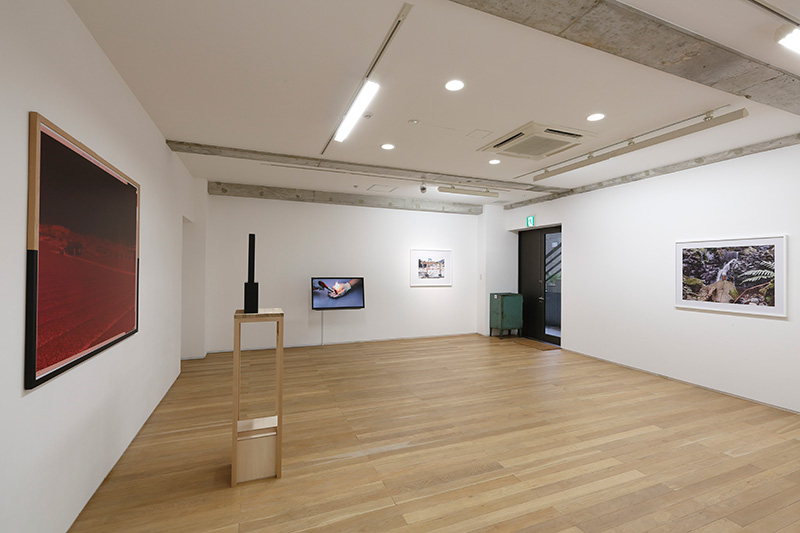
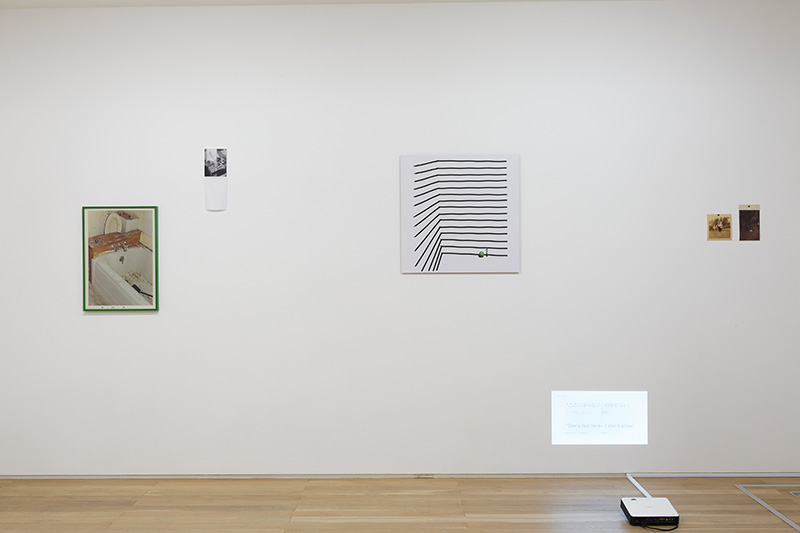
即興は時に本能をフルに使えますし、宇宙と交信する意気込みも湧き出てきます。朝日を浴びながら、プラモデルをつくる時みたいにパーツとパーツを丁寧に組み合わせたりしていると、違う時間軸へ飛び出している感覚もあります。暗い部屋でとにかくスピード感を意識して並べたりしている時もそうです。でも、敢えてとても疲れてる時に作業したりもします。アイデアのメモも書くしドローイングもします。やり方は色々ありますが、イメージする暇を脳に与えない生活が必要な時期というのはあります。それでも、ビカビカした直感はそんなに簡単にはやってこない。直感の精度を上げるのに大事だと思っている事が沢山あります。ぱっと思いつくのは、ランニング、読書、早寝早起きを毎日する事です。
-昨年の個展「Friday, September 9 – Friday, October 7, 2016」では『コレクターB』の写真作品と、その素材となる廃棄されたゴミを浮かべた水槽と、構成されたオブジェをガラスケースに収めたものが展示されていました。また、映像作品もありました。この展覧会はどのようなプロセスで構成されましたか。ひとつ大きな分岐点があって、そこから急激に作品が成長していきました。制作を始めた当初から不要とされたものを扱って作品をつくっていますが、そこで生じるからだを使いながら極端に集中する行為には、2010年辺りから5年くらい制限をかけていました。でも、その5年の間に精神をコントロールするすべをかなり身につけたので一昨年、思いきってその制限を解除したんです。それは、一昨年の夏におこなった「通行人間」という個展の開催期間中とも重なります。「通行人間」の制作では「死んでいる人」について考える事に多くの時間を費やしていて、その展示期間中に祖母が亡くなり、妹が妊娠するという事もあった。そういった出来事から、なんだかワクワクしてきっちゃった部分と全身で考えたいという欲望があって、そこに制限を解除するタイミングを重ねて、近所で落ちているものを拾い集めてスキャンすることを始めました。そこが大きな分岐点でした。
-体に無理のない範囲で制作を再開したということですか。からだに無理のない範囲の制作は、体調を崩してからある程度回復するまでにやっていた事です。一昨年、制限を解除してからは月に100枚程のペースでスキャンをする作業をベースにして、そこと、他に進めている、作品になるかならないかわからないものの制作との間を行ったり来たりしていました。それを続けていくうちに、そういった時間の中で色々なアイデアが生まれて構成されていきました。はじめから明晰なかたちで展覧会の構成があった訳ではありません。自分の身体や精神に積極的に負荷をかけて、限界の中で出来上がった成果とも言える展覧会です。制限を解除した当初から、精神面へのリスクが高いとわかっていてからだを使いながら極端に集中する行為を再開したので、そのリスクを補う為に毎日最低でも4kmはランニングすることも同時に始めました。多い日はこれを3セットくらいやります。ランニングは体調を整えるのに凄く効果的です。
Improvisation allows me to fully utilize my instincts, and also imparts an enthusiasm and ardor, as if I were communicating with the universe. When slowly, carefully attaching each piece in the morning with as if a devoted hobbyist assembling his model figurines, there are times when I feel as if I had been transported to another world where time flows differently. The same goes for when I’m working in a dark room and working, conscious of speed. But I also make a point of working even when I’m tired. I do jot down ideas in a notebook, and make sketches, too. It’s not necessarily uniform one way or the other. There are some periods when I need to live without giving my brain the leisure to settle on a specific image. Even so, epiphanies are few and far between. It takes the right conditions, and I think that there are many things which are vital to improving the caliber of inborn intuition. Off the top of my head, I would cite some banal examples: jogging, reading, and establishing a healthy routine of hitting the sack early and waking up early.
-In last year’s solo show “Friday, September 9 – Friday, October 7, 2016” you exhibited not only the “Collector B” prints, but also suspended scrap debris material in tanks of water, and displayed completed sculptures in glass showcases. You also screened a film. How did you come up with the concept for this ambitious exhibition?I experienced a significant turning point, and my works developed quite rapidly from there. From the very start, I’ve been interested in items that have been deemed unnecessary and discarded, and have used this items to create my work. Yet starting around 2010, there was a five-year period when I had to set limits when it came to delving too deeply into the work. Over those five years, I learned how to manage my mental health. Feeling that I was ready, I decided to free myself from all the previous limits, and really delve back into the work. This overlaps with the “Passing Man” solo show I did last summer. When preparing the show, I spent most of the time thinking about the dead. While the show was still running, my grandmother passed away, and my younger sister became pregnant. These events awakened something within me. I wanted to allow myself to fully experience and think again. Around the same time that I lifted the former self-imposed limitations, I began scanning the debris that I would collect in my neighborhood. That was a big, pivotal moment for me.
-You started to work again without overtaxing yourself physically.Yes, after getting sick, I had been holding back until I could make a full recovery. Two years ago, after lifting the self-imposed restrictions, I maintained a baseline of scanning about 100 sheets a month. Whenever I had time apart from the scanning, I would tinker with other potential pieces in progress. After sticking to this regimen for a while, other ideas began to gradually take form. So I didn’t necessarily begin with a masterplan for the exhibition. Rather, you could say that I saddled a heavy physical and emotional burden, and the exhibition was a product of having pushed myself to this (manageable) extreme. When I decided to push myself, I knew that there would be a high psychological risk. Since I was using my body to once again concentrate intently on work, I needed to offset the load, and that’s when I started to run at least 4km every day. Some days, I’ll repeat the run as much as three times, so 12km in total. Running is really effective for staying healthy.

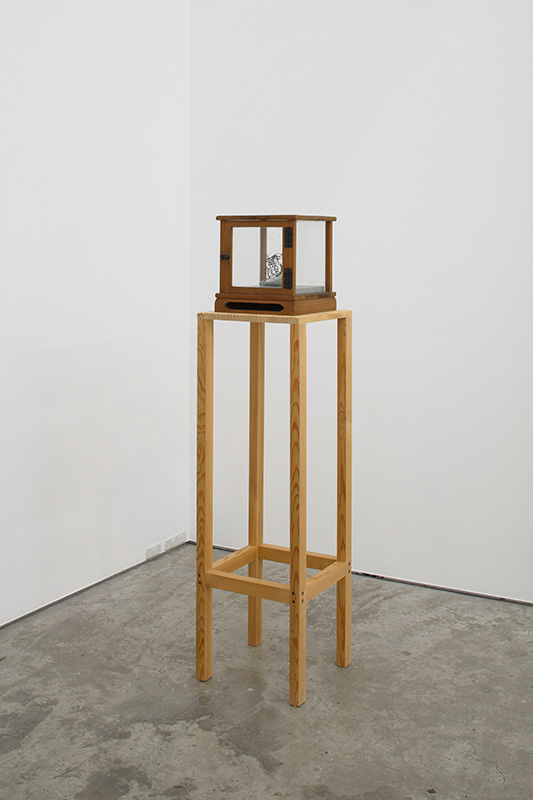
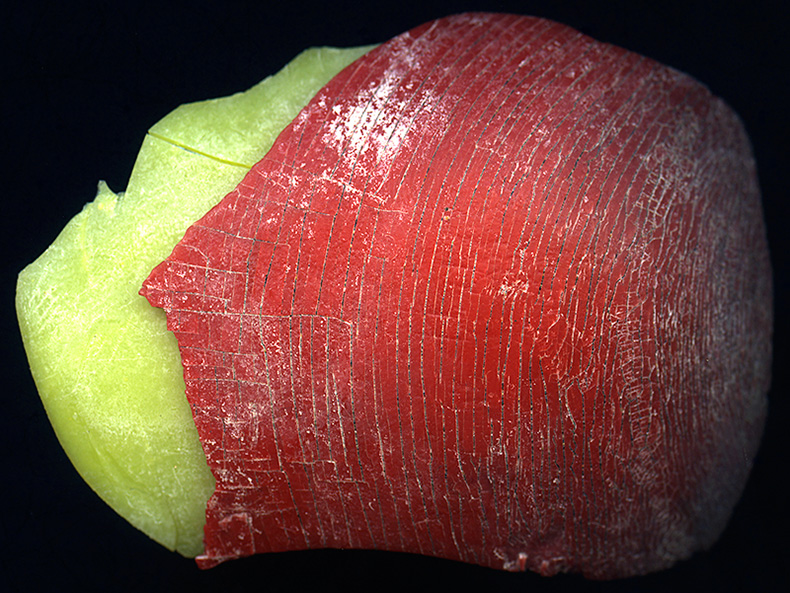
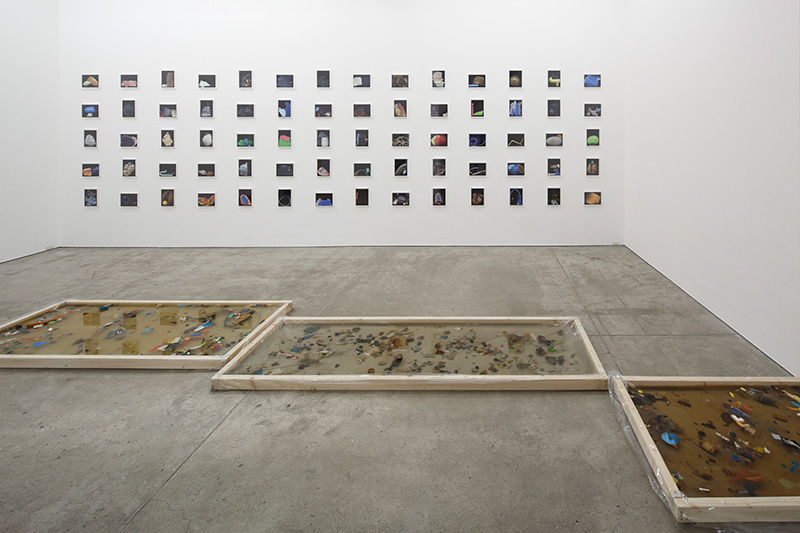
水槽の作品は展覧会が終われば捨ててしまいますが、また新たな「コレクターB」シリーズと共に蘇らせることもできます。その都度写真だけが残り、被写体の入った水槽はぼぼ跡形もなく消してしまうのですが、今回の水槽の中身から1点だけオブジェを取り出して保管してあります。次の作品でそれを扱うかもしれません。
-展覧会のタイトルがそのときの日付になっていることからも時間への意識を感じます。その日付ももう過ぎてしまいました。あっという間でした。
-『コレクターB』のプリント作品は朽ちていく物を収めているにも関わらず、軽やかな質感を帯び、用途のわからない未知の物体のように見えるところに魅力を感じます。そのひとつにスキャナー特有の焦点距離と正面からの照射が関係していると思いますが、カメラとスキャナーそれぞれの特性についてどうお考えですか。カメラもスキャナーも、プリントになった段階の特性としてはディテールの違いくらいに考えています。どちらも平面性や虚構性や等価性等のいわゆる写真の特性みたいなところは同じです。大きく違うのは撮影の段階で、カメラは人間の目に近い。スキャナーにもカメラは内蔵されていて箱の中で動きが限定されています。それも目に喩えれば、ガラス板の上に寝ているものを下から覗く様な限定された視点です。ものがガラス板の上に寝ていなければ暗闇とガラス板の汚れだけが写ります。ですから、スキャナーでオブジェを撮影して垂直な壁面にプリントを貼付けたりフレームに入れて壁にかけると、起つ残像、起たせたという出来事もやれる。ずっと地球の上に起つ事についてやってきていて、スキャナーを使った撮影も10年くらいやっているので、どちらの機材も自分の身体の一部です。
I ended up throwing out the water tank piece after the exhibition closed, but it will be possible to revive it with the new “Collector B” series. After the installation, only photographs remain, and the water tanks themselves vanish with almost no trace. But I did pluck one sole object from the tanks after the exhibition. I’ve kept it safe and might use it for my next project.
Titling the exhibition after the date is also indicative of your awareness of time.Those dates already belong to the past. Time flies.
-Even though the prints in “Collector B” depict items in various states of decay, they have a light, delicate feel. There’s a certain magical appeal in how they look like mysterious objects whose use is anyone’s guess. I suspect that the scanner’s focal length and head-on lighting have something to do with this aesthetic, but what are your thoughts on the characteristics of cameras versus scanners?My mindset is that, in the printing stage, individual characteristics of either cameras or printers are merely a difference of detail. They both share all the properties inherent to photographs – the flatness, the fictiveness, the equivalence, etc. The big difference comes when you’re shooting, as the camera is positioned close to the human eye. With scanners, the camera is tucked inside the machine, so any movement is limited to within that box. The perspective you get with a scanner is limited. Think of it this way: there’s an object resting on a glass panel, and you can only peek up from below. If the object is removed from the glass, you will only see darkness and the panel’s grime. Thus, when you use a scanner to photograph an object, put the print into a frame, and hang it on a wall, it means that you’ve also been able to create the flat afterimage of an event, and right this photographic representation vertically on the wall. All of my work has been about events that occur on this planet, and I’ve been using a scanner for almost 10 years. I’ve had so much experience with both scanners and cameras that they now feel like an extension of my own body.
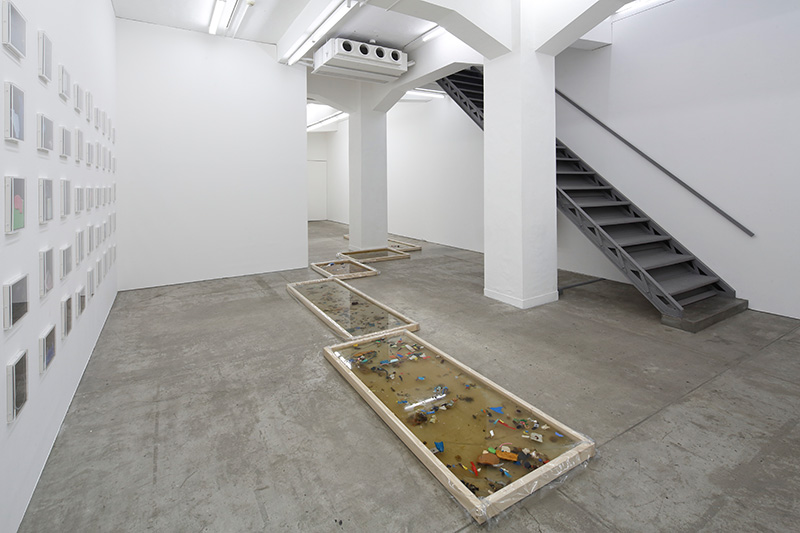
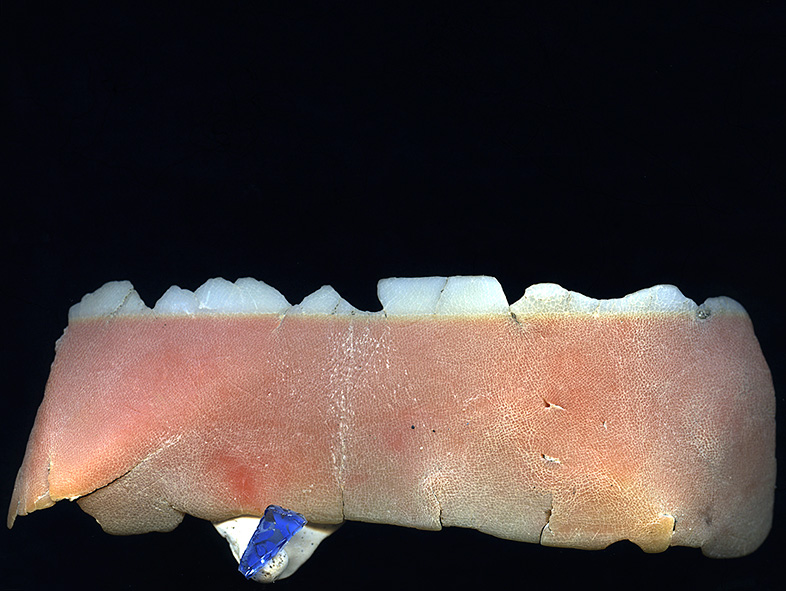
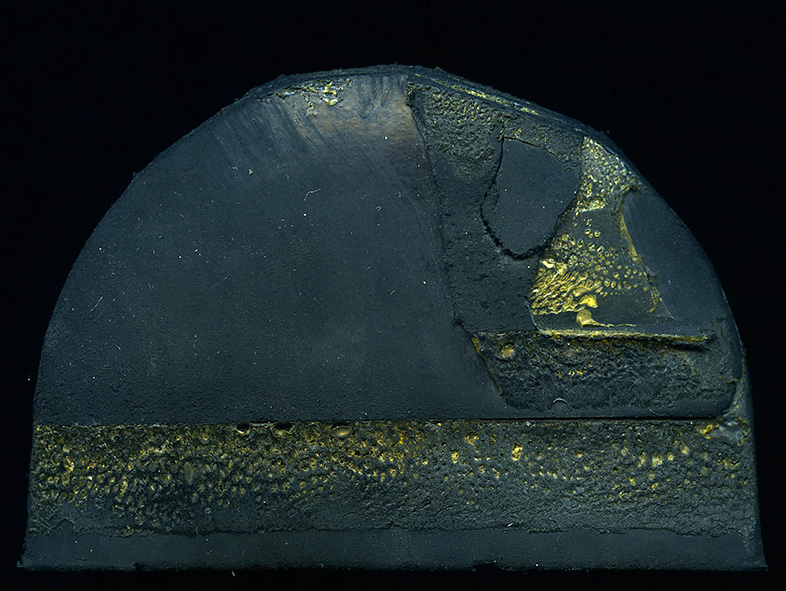
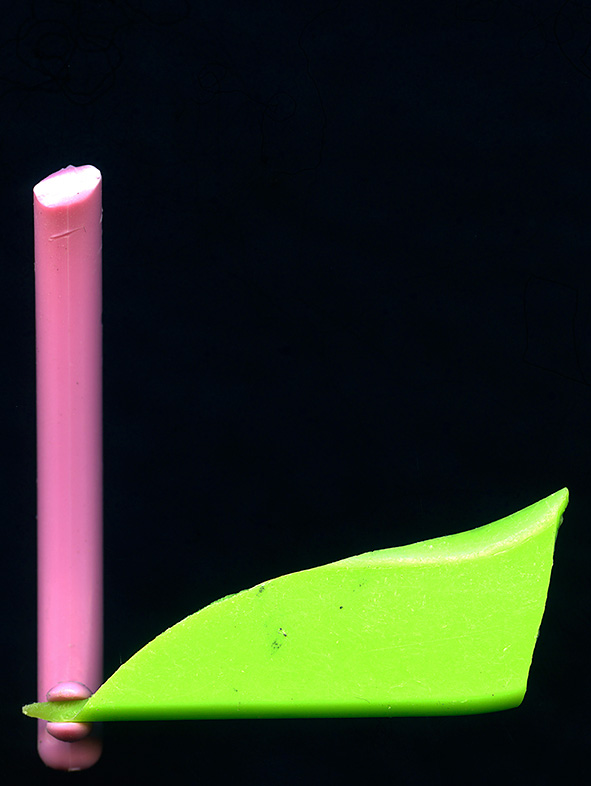
行為中のある状態においては、脳や精神の振れ幅を大きくする作用があります。そういった振れ幅の扱いきれない部分も含めていかに扱うかというのはやっています。行為の後に残っている痕跡の記録は、源の感覚を緩慢な時間と共に表してくれます。今は生きていて、いずれは死んでしまうけれど、全身で考えることが出来るというのは素晴らしいと思います。
-作品が作者の思考や感情といったものを取り込んで出来ているというのは当然なことなのですが、万代さんの作品からは、時に葛藤などを含めた、身体を伴う経験をより生々しく感じます。今の万代さんにとって、作ることとはどのようなことなのでしょうか。作品だけが、葛藤や経験、その他にも沢山のレイヤーを受け入れているんですよね。だから、作業するしないに大きな違いは無くて、世界にめがけて生きている事がつくることです。生活全部ですね。それで、常に15種類くらいの作品になるのかならないのかわからないものの制作を毎日少しずつ進めています。
-今回リリースする写真集『A Certain Collector B』は、架空のコレクターBが蒐集した画像のアルバム、もしくはスクラップブックという設定です。これは展示の延長線上で捉えると、過去に類する形になると思います。この写真集をどのような本と捉えていますか。写真集では、Bという人物がゴミの画像を集めてアルバムにしたけれど、誰かがそれを複製して商品化して消費されていく。遊び心と、シニカルな言い回しでそういう出来事をつくってみたかった部分があります。なので、本自体はプロセスです。本を手に取った人々が、実際には今後この本をどうしていくのかという変化や未知への興味が多分に反映されています。
-今回は初の出版となりますが、本を作ることに対して思うことはありますか。今回初めて出版を専門にしている方々と仕事をして、本づくりの面白さに気が付きました。本をアルバム形式にするアイデア等、交流の中から生まれたものです。これまでは本をつくることにまで興味が及ばなかったのですが、今は次の本の事も考えています。
大山光平, February, 2017
In the heat of the moment, all these activities are profoundly stimulating and amplify my mental oscillations. Working is a question of how to harness this stimulation, especially at times when the oscillations verge on the uncontrollable. The resulting work is a stationary document that evinces action, and reveals those original sensations along with the sluggish passage of time. We’re alive now but will ultimately die someday; it’s remarkable that we have this opportunity to think, with every atom of our sentient bodies.
-It goes without saying that a work of art is intrinsically imbued with the ideological and emotional mark of its creator. At times, I can detect quite a vivid narrative of your own struggles and physical experience that seem to be present in some of your pieces. What does the creative process, the act of producing work, mean to you nowadays?The works alone are conducive to layer after layer of struggle, experience, etc. As such, I don’t see any significant difference in whether I work or not; the act of trying to live in the wider world is itself an act of creation and tantamount to producing work. It’s everything, every aspect of daily life. I’m always working on a lot of pieces simultaneously – maybe they’ll end up being 15 or so completed works – but the number is arbitrary. I just take small steps each day and work on new pieces little by little.
-Your new photobook, “A Certain Collector B,” is stylized to be a scrapbook of sorts, an album of images fastidiously assembled by the fictive collector known only as “Collector B.” If we were to situate this book in the context of your exhibitions, I think it would correlate with some of your previous work. What are your own views on this photobook, and how does it fit into your larger oeuvre?The photobook’s premise is that a character identified as “B” collected these images of trash, and then someone else stepped in to subsequently reproduce the album as a consumable commercial product. In a sense, I wanted to try and bring this scenario to fruition, motivated by a sense of playfulness and also a dose of cynicism. As such, the book itself is a matter of process. The project largely reflects my own interest in the unknown variables and future transformations that would actually await such a book in the hands of real world consumers.
-With a first publication under your belt, do you have any closing thoughts on book making?This was my first opportunity to work with publishing professionals, and opened my eyes to how interesting the book-making process can be. For example, the idea to present the book in album-format itself arose from our discussions; the collaboration process proved to be fertile ground for new inspiration. Until now, the notion of creating a book had been outside my range of interests. That said, I’m already thinking about the next publication.
Kohei Oyama, February, 2017
万代洋輔 | Yosuke Bandai
1980年 東京生まれ、東京にて制作活動。
主な個展に 2016年「Friday, September 9 – Friday, October 7, 2016」TARO NASU 、2015年「通行人間」CAPSULE 、2014年「あばら骨しか信頼してないじゃないですか俺」TARO NASU 、2012年「病める万代、無類無敵の情熱」AI KOWADA GALLEY 、グループ展に2017年「シルバニアファミリービエンナーレ2017」XYZ collective 、2016年「囚われ脱獄、囚われ脱獄」statements 、2015年「Continuous Temporality Vol.2 『Mortal』」gallery COEXIST-TOKYOなど。
その他に「Super Open Studio NETWORK」や「Ongoing Collective」の活動にも参加している。
今年の2月には、初の出版物「A Certain Collector B」をNewfaveより刊行。そのローンチエキシビジョンをPOSTにて開催。10月には、愛知県美術館 APMoA Project, ARCHにて個展を開催予定。
A Certain Collector B
Launch Exhibition | YOSUKE BANDAI
会場 : POST (http://post-books.info)
150-0022 東京都渋谷区恵比寿南 2-10-3
会期 : 2017年2月17日 – 3月5日 12:00-20:00
オープニングレセプション : 2月17日18:00-20:00
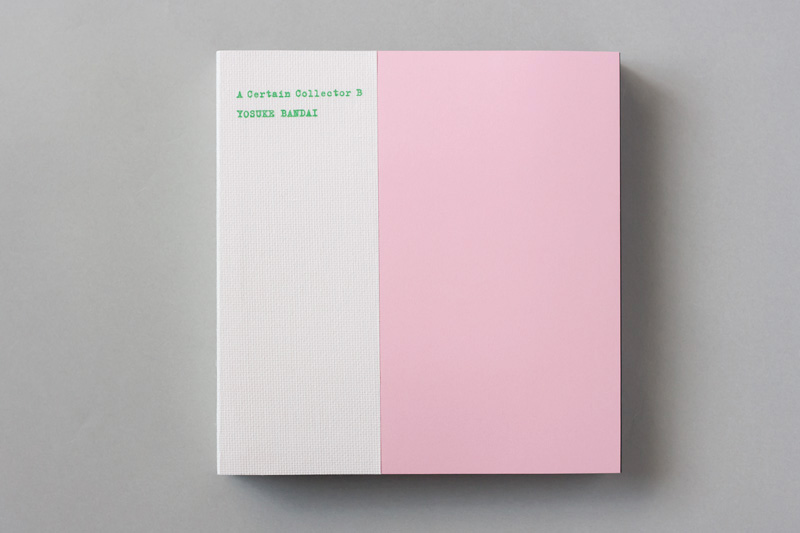
BOOK ‘A Certain Collector B’
Detail >>
Yosuke Bandai
1980 Born in Tokyo Lives and works in Tokyo
Major Solo Exhibitions |
2016 “Friday, September 9 – Friday, October 7, 2016” TARO NASU
2015 “Passing Man” CAPSULE
2014 “I trust only the rib, after all, you know?” TARO NASU
2012 “Disordered Bandai; His Unequalled Passion” AI KOAWADA GALLERY
Major Group Exhibitions |
2017 “Sylvanian Families Biennale 2017” XYZ collective
2016 “Imprisoned, Jailbreak, Imprisoned, Jailbreak” statements
2015 “Continuous Temporality Vol. 2 – Mortal” gallery COEXIST-TOKYO
In addition, he is a participating member of the “Super Open Studio NETWORK” and “Ongoing Collective.”
In February 2017, Newfave will publish his first book: A Certain Collector B. A launch exhibition is to be held at POST.
A solo exhibition is scheduled for October 2017 at the Aichi Prefectural Museum of Art, under the auspices of the APMoA Project, ARCH.
BOOK ‘A Certain Collector B’
Launch Exhibition
Venue: POST (http://post-books.info)
2-10-3, Ebisu-minami, Shibuya-ku, Tokyo 150-0022
When: Feb. 17th (Fri.) – March 5th (Sun.) 2017 12:00-20:00
Opening Reception: Feb. 17th 18:00-20:00
